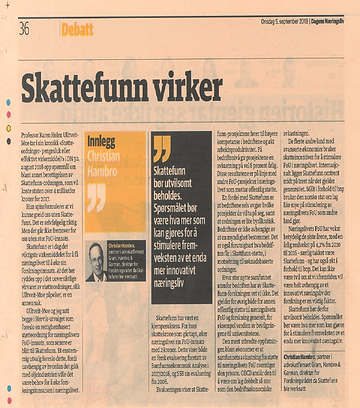
Professor Karen Helen Ulltveit-Mo, in her chronicle, "Support schemes - money-laundering or effective means?" In DN 30 August 2018 raises questions about, among other things, the justification of the SkatteFUNN scheme, which will cost the state more than NOK 4 billion for 2017.
She pointed out that we could have done it without Tax Return. Of course, that's right. But it will not be possible for us without great R&D efforts. Today, SkatteFUNN is the most important tool for getting the business sector to increase its research efforts. That it should be cleaned up in the confusing jumble of support schemes, as Ulltveit-Mo points out, is another matter.
Ulltveit-Mo and I both sat in the Hervik committee, which proposed a rights-based support scheme for the R&D efforts of the business community, which later became SkatteFUNN. There was a unanimous selection that suggested this, because regardless of how things went with the oil industry, there was a need to increase research efforts in business.
SkatteFUNN has been a huge success. For every lost tax crown, the business sector increases its R&D efforts by NOK 2. This shows both the recent evaluation carried out by Socio-economic Analysis in 2017/2018, and the evaluation SSB carried out in 2008. The evaluation shows that SkatteFUNN, R&D - the projects lead to higher competence in the companies and to increased labor productivity. At the corporate level, the projects yield a return of just over 8 % annually. These results are in line with other R&D projects in the business sector that receive public support.
One advantage of SkatteFUNN is that the companies themselves decide which projects they want to undertake, and the scheme is not bureaucratic. Businesses do not depend on any authority deciding. It is also predictable what the company gets in TaxFUNN support, as opposed to application-based schemes.
We do not know how much benefit the rest of society outside the company has from the SkatteFUNN research. This also applies to other public support for business R&D and research in general, such as the value of grants to universities. The most prevalent view of economics is that society's return on support for business R&D exceeds the private sector. The OECD estimates it to be about twice the business return.
Most other countries with advanced economies use tax incentives to stimulate research and development in business. Internationally, SkatteFUNN is in the middle of the tree when it comes to generosity. Measured in relation to GDP, the Norwegian state spends about as much on stimulating business R&D as other countries do.
Business R&D has grown significantly in recent years, with annual real growth of 4.11 TP1 from 2010 to 2016, not least thanks to the Tax Fund, and has also increased in relation to GDP. There can be no doubt that in the future we will depend entirely on an innovative business community where research is an important factor. Taxes should therefore undoubtedly be retained. The question should be what more can be done to stimulate the emergence of an even more innovative business community.
Christian Hambro is a partner in the law firm Gram, Hambro & Garman. He was a member of the Hervik committee that proposed the Tax Fund scheme. He was director of the Research Council when SkatteFUNN was released. He has been an adviser to the EU Commission on tax incentives, and has published the book "Tax Fund Rules and Practices".
If you have a tax FOUND or tax question, contact your tax expert and lawyer Christian Hambro (ch@ghg.no).
On September 5, 2018, lawyer Christian Hambro published a post in Dagens Næringsliv about the Tax Fund scheme:





